Last updated by: bg-11, Last updated on: 15/12/2024
Wazuh 4.5.0 - Backup and Redeploy
Document Creation: 14 Dec, 2024. Last Edited: 14 Dec, 2024. Authors: Bikendra Gurung.
Effective Date: 14 Dec 2024. Expiry Date: 14 Dec 2025.
Step 1: Check Running Wazuh Instances/Services
- Check Running Wazuh Instances:
docker ps
Step 2: Backup Wazuh Data
1. Backup Wazuh Manager Data
1.1. Enter the Wazuh Manager container:
docker exec -it --user root single-node-wazuh.manager-1 bash
1.2. Create a compressed backup:
tar -czvf /var/ossec_backup.tar.gz /var/ossec
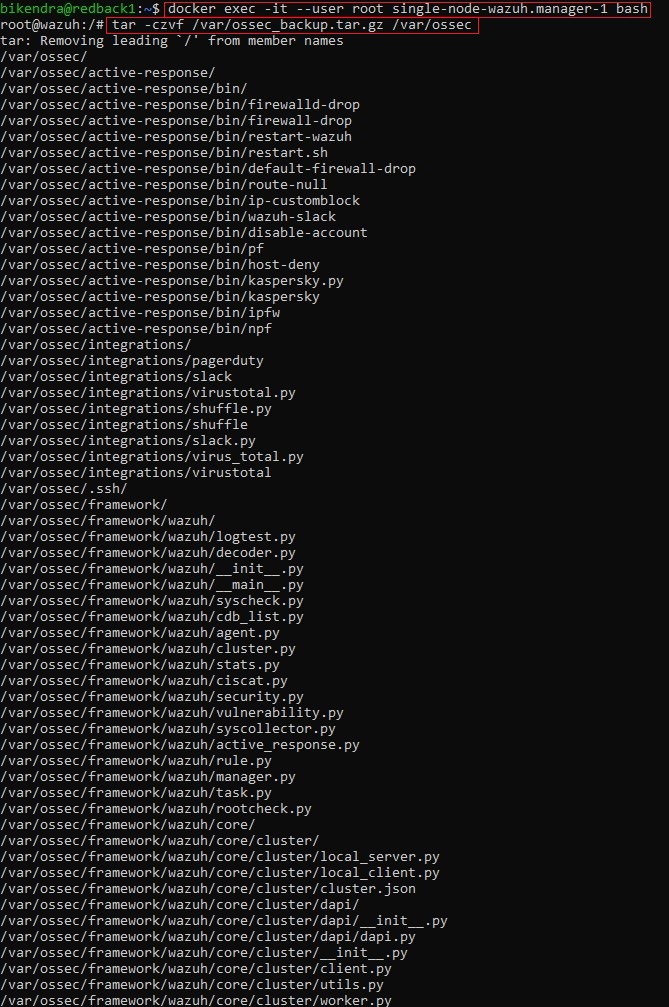
1.3. Exit the container:
exit
1.4. Copy the backup to the host machine:
Note: This step copies the backup to the current working directory (e.g.,
/home/usr/). To copy the backup to a centralized location, skip this step and follow the instructions in Section 4.
docker cp single-node-wazuh.manager-1:/var/ossec_backup.tar.gz ./ossec_backup.tar.gz

2. Backup Wazuh Indexer Data
2.1. Enter the Wazuh Indexer container:
docker exec -it --user root single-node-wazuh.indexer-1 bash
2.2. Navigate to the /usr/share directory:
cd ../
2.3. Verify that the wazuh-indexer directory exists:
ls
2.4. Create a compressed backup:
tar -czvf /usr/share/wazuh.indexer_backup.tar.gz /usr/share/wazuh-indexer/
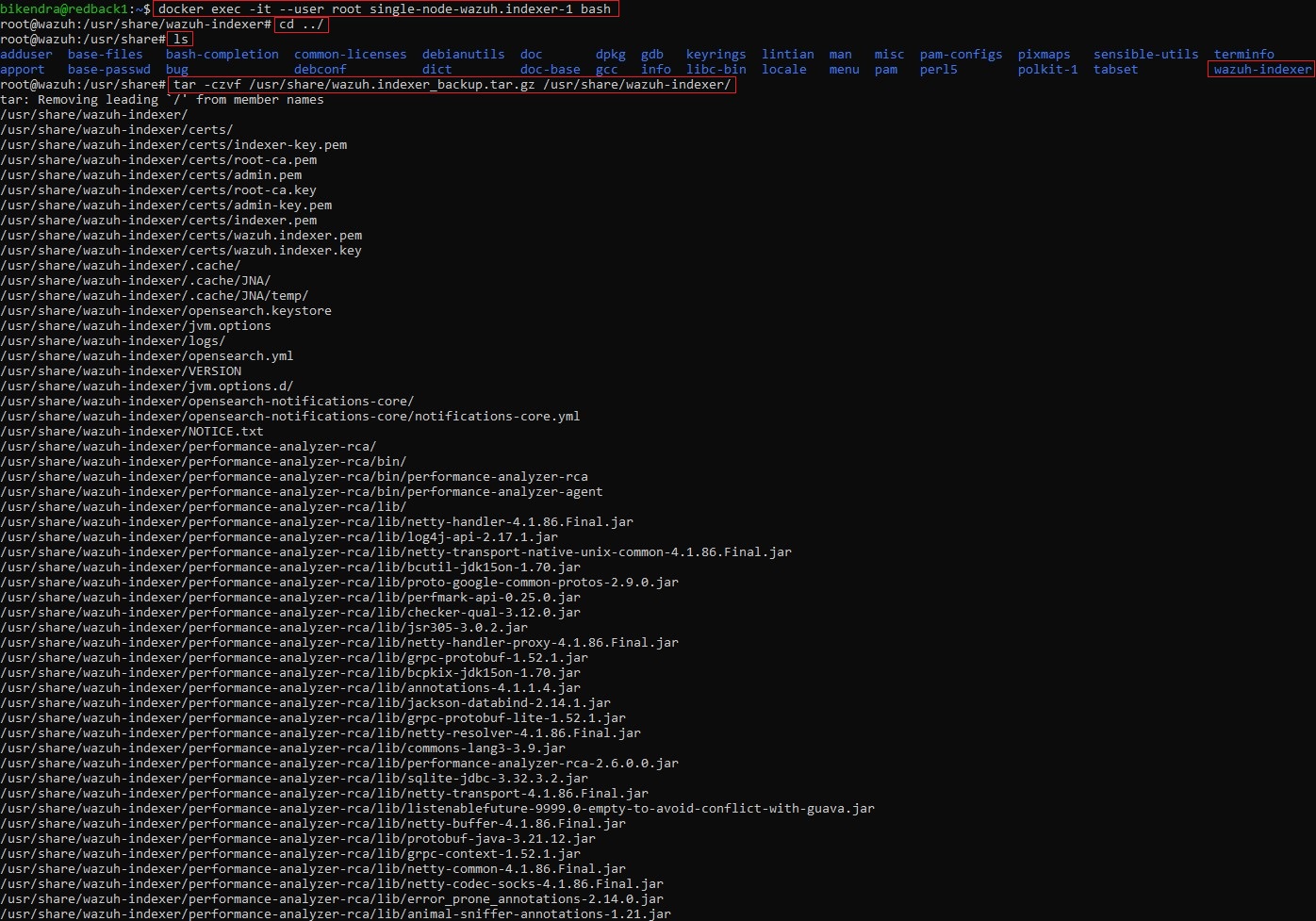
2.5. Exit the container:
exit
2.6. Copy the backup to the host machine:
Note: This step copies the backup to the current working directory (e.g.,
/home/usr/). To copy the backup to a centralized location, skip this step and follow the instructions in Section 4.
docker cp single-node-wazuh.indexer-1:/usr/share/wazuh.indexer_backup.tar.gz ./wazuh.indexer_backup.tar.gz
![]()
3. Backup Wazuh Dashboard Data
3.1. Enter the Wazuh Dashboard container:
docker exec -it --user root single-node-wazuh.dashboard-1 bash
3.2. Navigate to the /usr/share directory:
cd ../
3.3. Verify that the wazuh-dashboard directory exists:
ls
3.4. Create a compressed backup:
tar -czvf /usr/share/wazuh-dashboard_backup.tar.gz /usr/share/wazuh-dashboard
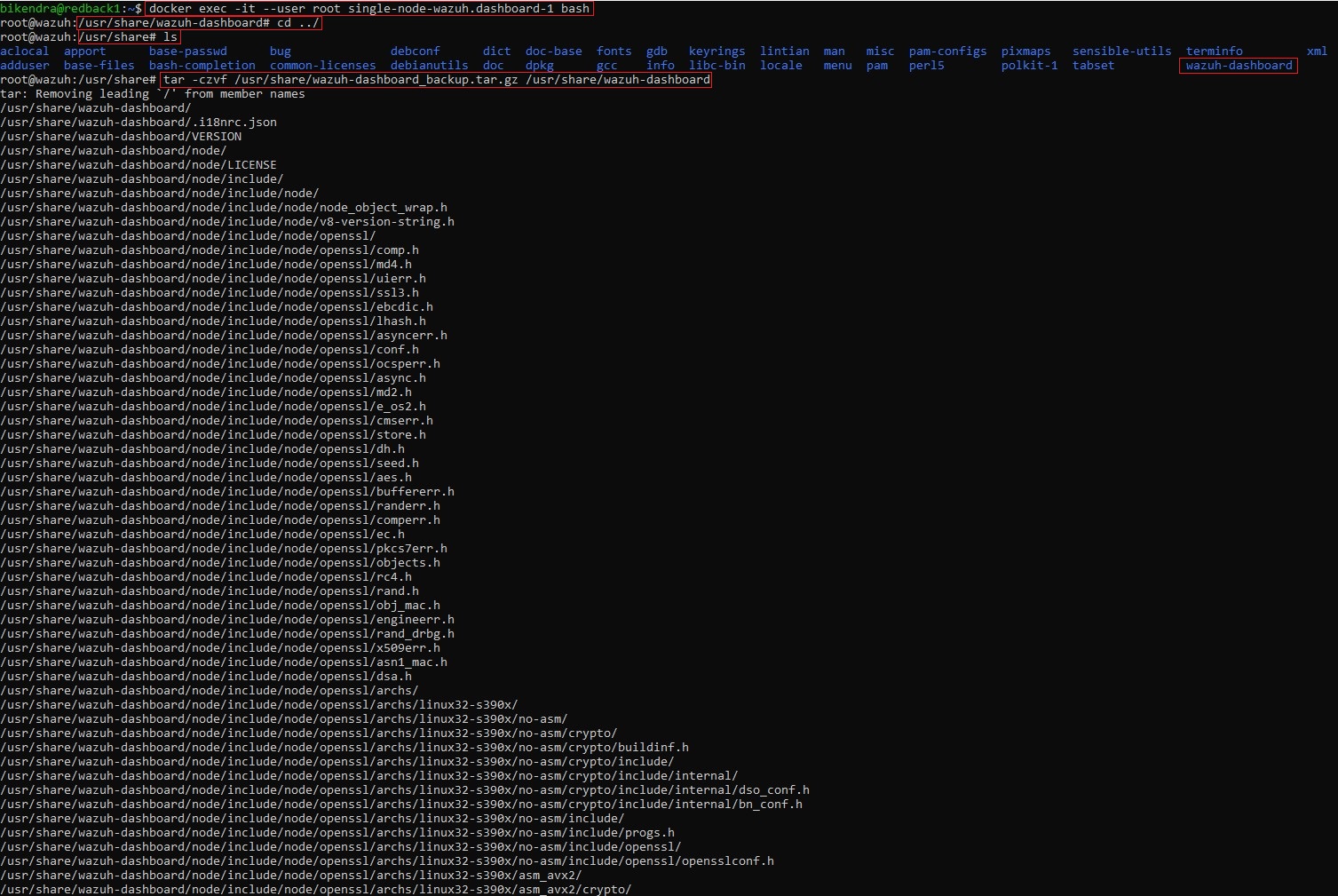
3.5. Exit the container:
exit
3.6. Copy the backup to the host machine:
Note: This step copies the backup to the current working directory (e.g.,
/home/usr/). To copy the backup to a centralized location, skip this step and follow the instructions in Section 4.
docker cp single-node-wazuh.dashboard-1:/usr/share/wazuh-dashboard_backup.tar.gz ./wazuh-dashboard_backup.tar.gz
![]()
4. Create a Centralized Backup Location
4.1. Create a centralized directory if it does not already exist:
[ -d /var/backups/wazuh ] || mkdir -p /var/backups/wazuh
4.2. Ensure only users with root privileges can access the directory:
chown root:root /var/backups/wazuh
chmod 700 /var/backups/wazuh
4.3. Copy backups to the centralized location:
-
Wazuh Manager:
docker cp single-node-wazuh.manager-1:/var/ossec_backup.tar.gz /var/backups/wazuh/ossec_backup.tar.gz -
Wazuh Indexer:
docker cp single-node-wazuh.indexer-1:/usr/share/wazuh.indexer_backup.tar.gz /var/backups/wazuh/wazuh.indexer_backup.tar.gz -
Wazuh Dashboard:
docker cp single-node-wazuh.dashboard-1:/usr/share/wazuh-dashboard_backup.tar.gz /var/backups/wazuh/wazuh-dashboard_backup.tar.gz
Step 3: Remove all Wazuh Services, Images, and Volumes
1. Remove Wazuh Services
1.1. Remove all Wazuh services/containers:
docker compose -f /opt/deploy/wazuh-docker/single-node/docker-compose.yml down

1.2. Alternatively, remove them individually:
docker compose -f /opt/deploy/wazuh-docker/single-node/docker-compose.yml rm -f wazuh.dashboard wazuh.manager wazuh.indexer
2. Remove Wazuh Images
docker rmi wazuh/wazuh-manager:4.5.0 wazuh/wazuh-indexer:4.5.0 wazuh/wazuh-dashboard:4.5.0
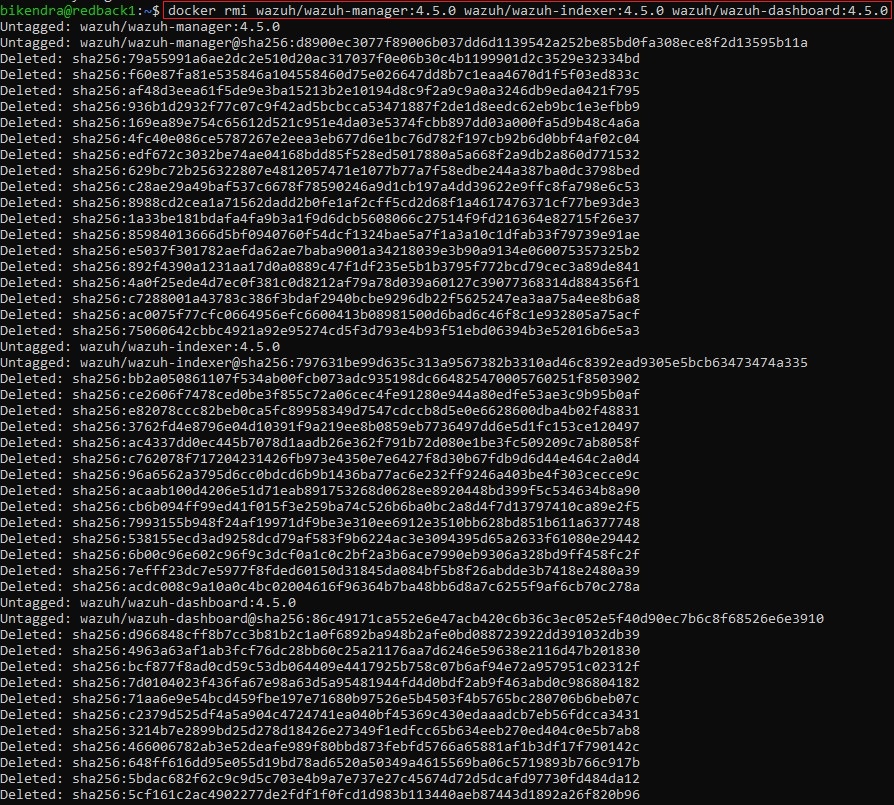
3. Remove Wazuh Volumes
3.1. Check Docker volumes associated with Wazuh:
docker volume ls
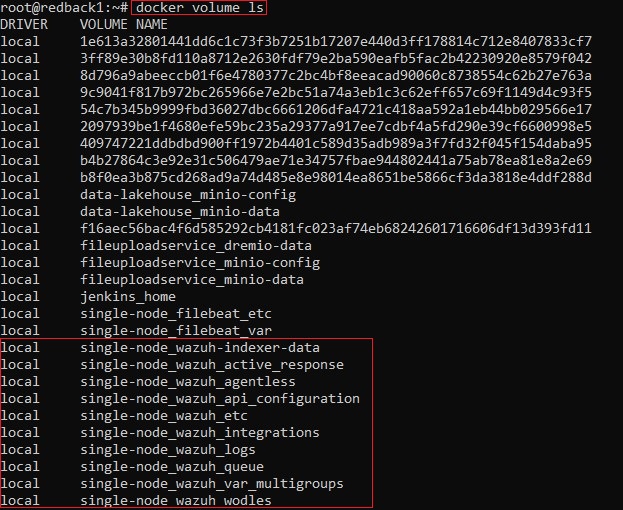
3.2. Remove Docker volumes:
- Individually:
docker volume rm single-node_wazuh-indexer-data \
single-node_wazuh_active_response \
single-node_wazuh_agentless \
single-node_wazuh_api_configuration \
single-node_wazuh_etc \
single-node_wazuh_integrations \
single-node_wazuh_logs \
single-node_wazuh_queue \
single-node_wazuh_var_multigroups \
single-node_wazuh_wodles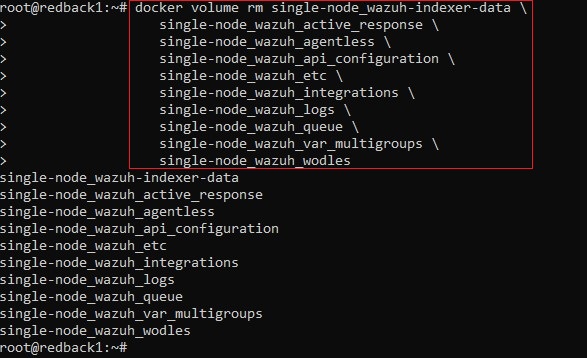
- Based on naming conventions:
docker volume ls | grep -E 'single-node_wazuh' | awk '{print $2}' | xargs docker volume rm
Step 4: Verify Removal of Wazuh Services
- Verify all services are removed:
docker ps
Step 5: Install Wazuh
1. Set Up Environment
1.1. Switch to root:
sudo su
1.2. Configure the system's virtual memory:
echo "vm.max_map_count=262144" | sudo tee -a /etc/sysctl.conf
2. Install Docker and Docker Compose
2.1. Install Docker:
curl -sSL https://get.docker.com/ | sh
2.2. Install Docker Compose:
curl -L "https://github.com/docker/compose/releases/download/v2.20.3/docker-compose-$(uname -s)-$(uname -m)" -o /usr/local/bin/docker-compose
2.3. Make Docker Compose executable:
chmod +x /usr/local/bin/docker-compose

3. Deploy Wazuh
3.1. Navigate to the deployment directory:
cd /opt/deploy
3.2. Remove any old Wazuh Docker repository:
ls
3.3. Clone the Wazuh 4.5.0 Docker repository:
git clone https://github.com/wazuh/wazuh-docker.git -b v4.5.0
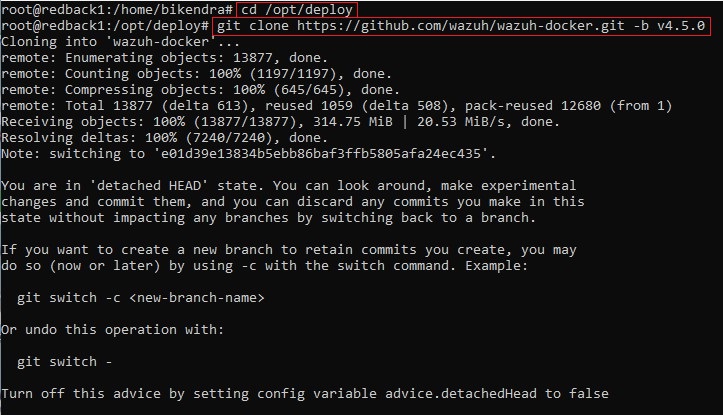
3.4. Navigate to the single-node directory:
cd wazuh-docker/single-node/
3.5. Generate the indexer certificates:
docker compose -f generate-indexer-certs.yml run --rm generator

3.6. Start all Wazuh containers:
docker compose up -d
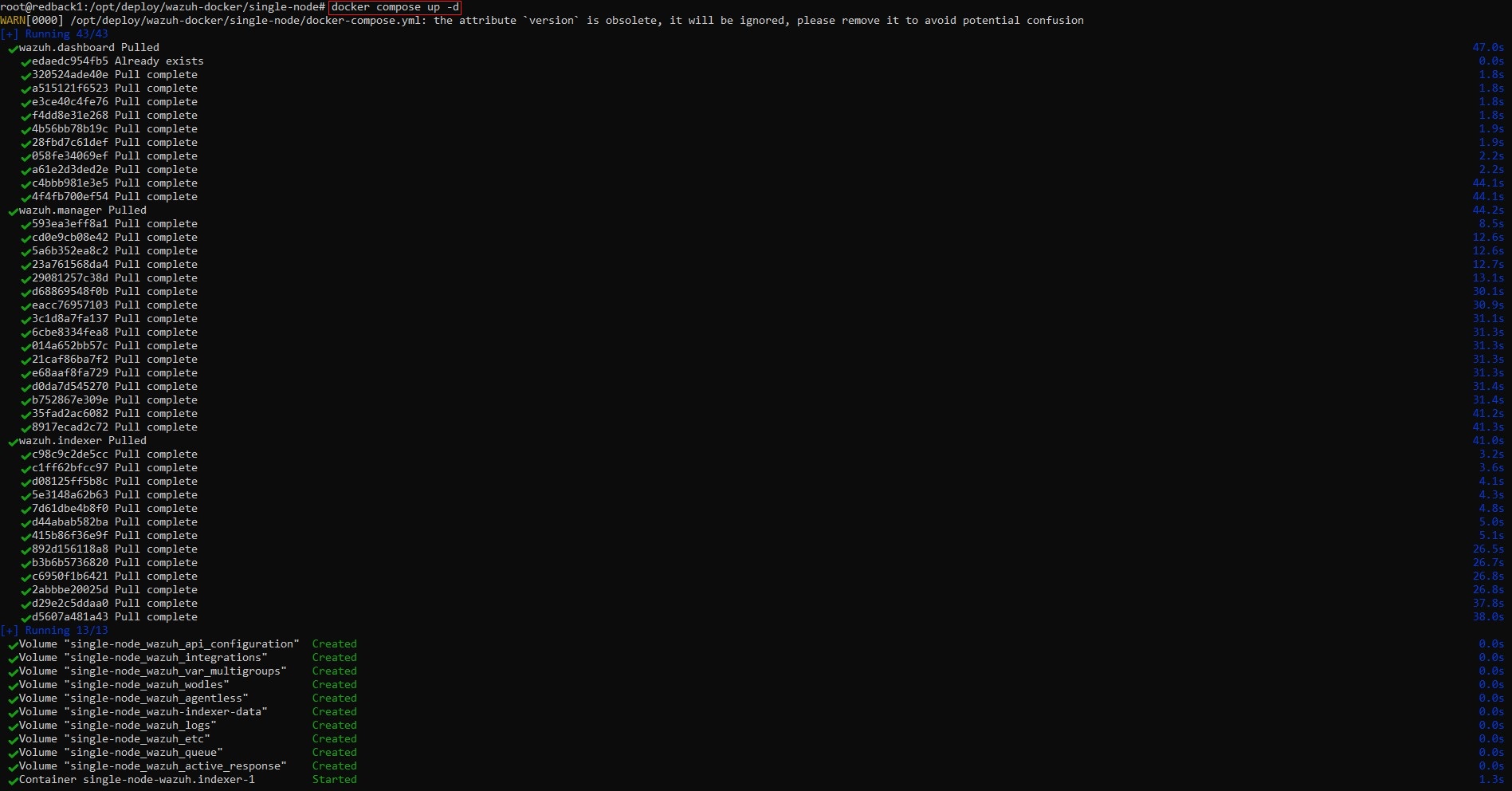

3.7. Start individual services if needed:
docker compose -f /opt/deploy/wazuh-docker/single-node/docker-compose.yml up -d
Step 6: Confirm Installation
- Check that all required Wazuh instances/services are running:
docker ps